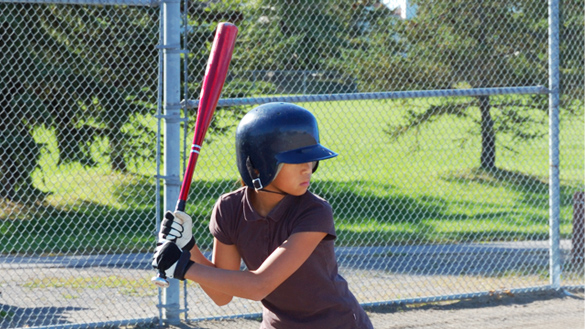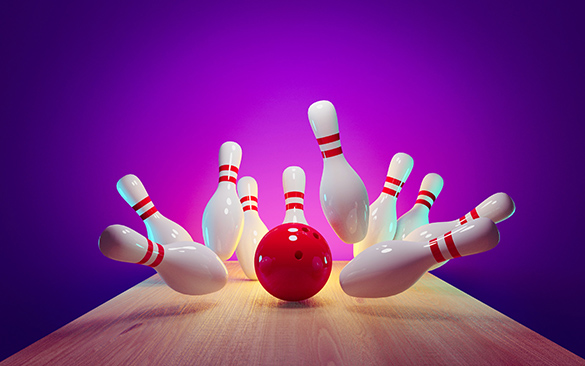Minds On
Batting averages

Baseball players’ batting averages are reported as decimal thousandths. Ashourina has a little league batting average of 0.286. This means they are expected to hit the ball 286 times out of 1,000 times at bat.

How can you model this using a thousandths grid? A thousandths grid is similar to a hundredths grid, but instead of having 100 cells it has 1000 cells.
Brainstorm
Brainstorm
Explore the following questions and discuss answers with a partner, if possible, or record your answers in a method of your choice.
1. About how many hits in 100 times at bat would you expect Ashourina to get? Use the thousandths grid to help you.
2. About how many hits in 10 times at bat would you expect Ashourina to get? How would this appear on the grid?
Action
Rounding decimals
You can round decimals just like you round whole numbers. When observing the thousandths grid in the Minds On activity, decimals were rounded based on the amount they were closest to.
To round decimals:
- Find the place value you want to round to (the “rounding digit”) and go to the digit just to the right of it.
- If that digit is less than 5, do not change the rounding digit but drop all digits to the right of it.
- If that digit is greater than or equal to five, add one to the rounding digit and drop all digits to the right of it.
Examples:
- Round 2.439 to the nearest tenth.
The digit 4 is in the tenth column. We go to the right of the rounding digit and find a 3 (less than 5), so the rounding digit stays the same and we drop the rest of the digits to the right.
Press the “Answer” button to reveal the answer to the question.
2.4
- Round 2.439 to the nearest hundredth.
The digit 3 is in the hundredth column. We go to the right of the rounding digit and find a 9 (greater than 5), so we add one to the rounding digit and drop all the digits to the right of it.
Press the “Answer” button to reveal the answer to the question.
2.44
Swim meet

Five swimmers are competing in the Junior Swim Canada competition. They are timed as they swim the pool lane. Times are recorded up to one hundredth of a second.
Four of the swimmers have had their turns. Their scores are:
9.8 s 9.75 s 9.79 s 9.81 s.
 Description
Description
Number line from 9.7 to 10 with swimmer 2 placed 5 tick marks after 9.7, swimmer 3 placed 1 tick before 9.8, swimmer 1 on 9.8, swimmer 4 1 tick after 9.8
- What score must the last swimmer get in order to win the competition? Explain why.
- Rank the swimmers from fastest time to slowest time.
- What would happen if swim times were recorded up to a tenth of a second? Or only recorded up to the full second?
- Explain why decimals are important in this situation.
- What other sports need to record using decimals? Why is this so?
In the next section we’ll explore rounding decimals in a different context. As we’ve learned so far, decimal numbers can be rounded in different ways and rounding makes a number easier to work with. In this section we practiced rounding swim scores. In the next section, we’ll be rounding numbers in another real-life context, this time with money.
Consolidation
Opening your own bowling alley
Mr. and Mrs. Shamon are excited to announce the grand opening of their new bowling alley in town. The bowling alley has various services. Customers can enjoy playing games at an hourly rate, rent bowling equipment and host a birthday party. The snack bar offers food and drink, and the Team Shop sells apparel.

When owning a business, purchases for items to use and sell come in bulk. The unit prices end up with decimal quantities.
For example, a box of 30 bowling balls cost $605.00, so each bowling ball comes to $20.16666.
The Shamon’s need help putting together their price lists because they must round all the decimals.
Using a method of your choice, help design and put together the price lists for one of the following: the bowling alley game room, snack bar or apparel/team shop.
To make buying transactions easier:
- game room prices will be rounded to the nearest dollar (whole number);
- snack bar prices rounded to the nearest ten cents(tenths);
- apparel to the nearest cent (hundredths).
Unit prices are below.
Lane rental per hour (4-6 people) $8.756
Single game play $7.412
Party rental (4 lanes, 2 hours) $63.523
League rental (per team player) $2.798
Saturday night disco bowl (per person) $11.730
Shoe rental $4.132
Ball rental $3.433
Burger $2.651
Fries $1.389
Nachos $4.509
Hot Dog $3.093
Pop $0.956
Juice $1.071
Water $2.031
Shoes $32.761
Shirt $17.936
Socks $2.1538
Jacket $28.751
Ball $20.1666
Ball bag $21.987
Reflection
As you read the following descriptions, select the one that best describes your current understanding of the learning in this activity. Press the corresponding button once you have made your choice.
I feel...
Now, expand on your ideas by recording your thoughts using a voice recorder, speech-to-text, or writing tool.
When you review your notes on this learning activity later, reflect on whether you would select a different description based on your further review of the material in this learning activity.
Press ‘Discover More’ to extend your skills.
Discover MoreThree friends are at the bowling alley. Consider the cost of lane rental, food and purchases. How much does an evening out with your friends cost?
Connect with a TVO Mathify tutor
Think of TVO Mathify as your own personalized math coach, here to support your learning at home. Press ‘TVO Mathify’ to connect with an Ontario Certified Teacher math tutor of your choice. You will need a TVO Mathify login to access this resource.
TVO Mathify (Opens in new window)